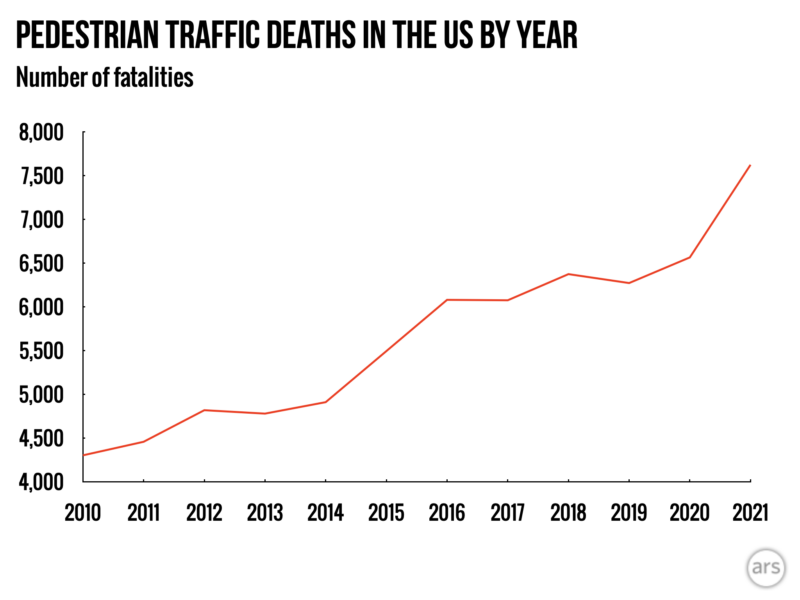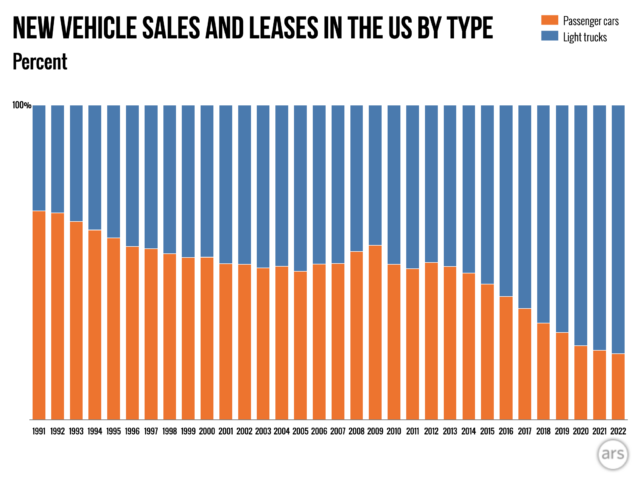How cities can stem the tide of pedestrian deaths from large cars and SUVs
Ever-larger cars and trucks are causing a safety crisis on US streets.
How cities can stem the tide of pedestrian deaths from large cars and SUVs
Ever-larger cars and trucks are causing a safety crisis on US streets.
KEVIN J. KRIZEK, THE CONVERSATION - 8/3/2023, 9:44 AM
Enlarge / Pedestrian deaths are rising sharply: From 2011 through 2021, annual US pedestrian traffic fatalities increased by 77 percent, from 4,302 to an estimated 7,624. In 2021 pedestrians represented nearly 18 percent of all traffic deaths.
Deadly traffic incidents have declined in most developed countries in recent years. But in the US they’re becoming more common. Deaths in motor vehicle crashes rose more than 33 percent from 2011 to 2021. Since 2010, pedestrian deaths nationwide have climbed a shocking 77 percent, compared with a 25 percent increase in all other types of traffic fatalities.
Light trucks injure pedestrians more severely than passenger cars in crashes, and the size of cars and trucks sold in the US continues to swell. Some current models, such as the Toyota Rav4, are one-third larger than they were 15 years ago.
Based on my experience researching urban planning and street design for the past three decades, I know that US cities are primarily vehicle-centered rather than human-centered. Rules established in the 1920s govern how people use vehicles in public streets, and other governmental controls tell manufacturers how big those vehicles can be.
Today, these sets of rules have created public spaces where it is safer to be inside a vehicle than outside.
The US has not moved as quickly as other countries to prioritize the safety of people outside of cars, especially as cars have grown larger and heavier. As a consequence, Americans are paying the price in lives lost, skyrocketing public health costs, and reduced mobility.
Large SUVs and trucks increase the risk of ‘frontover’ accidents, in which drivers strike someone in the vehicle’s large front blind zone.
Larger, heavier, and deadlier
Data clearly shows that since 2008, cars and trucks sold in the US have been continually getting bigger. The Department of Transportation’s corporate average fuel economy standards have constrained overall gasoline consumption but have also led to an increase in vehicle size.That’s because these standards have two sets of rules: one for cars and a looser set for light trucks. As a result, automakers have built more sport utility vehicles and light trucks, as well as cars designed to meet light truck standards, like the Subaru Outback. For almost a decade, they have increasingly moved away from producing small cars and sedans.
Modern auto showrooms are dominated by sport utility vehicles, minivans, and pickup trucks. According to 2022 data from the US Environmental Protection Agency, three-quarters of new vehicles produced in the US are light trucks.

Most vehicle sales and leases in the US are light trucks. Light trucks, including vans, minivans, sport utility vehicles, and pickup trucks, have increased their share of the new vehicle market from 33 percent in 1990 to 78 percent in 2022.
Those large vehicles create severe safety hazards on neighborhood city streets for children or adults who might be walking or cycling. Because these vehicles are taller, they are more likely to strike people at higher points and produce head or neck injuries rather than leg injuries. Their larger frames worsen visibility for drivers, especially when a vehicle is turning.
As a result, transport agencies, journalists, and public safety advocates are increasingly identifying large vehicles as a significant impediment to creating communities with safer streets.
A slow federal response
Until now, the US has not enacted regulations that require car manufacturers to consider the safety of anyone outside of cars. Now, however, the National Highway Traffic Safety Administration is proposing to add information to its crash test ratings measuring how well cars protect pedestrians in crashes. For example, bumpers and hoods could be redesigned to bend more easily and absorb more energy if a vehicle strikes a person.But as currently proposed, pedestrian safety would not be factored into the overall five-star safety rating. A vehicle could receive a failing grade for protecting pedestrians yet still earn a five-star safety rating overall.
People deserve to safely travel on public streets and in parking lots. In my view, the quickest and most effective way to tackle car bloat is to transform social expectations for the shape and size of vehicles. Several European cities show how this kind of shift can happen.
A time for local action
Amsterdam and Copenhagen are widely viewed as models for using public space in ways that prioritize people—but they weren’t always that way. Starting in the 1970s, grassroots movements in both cities pressed officials to reduce the dominance of cars and make streets safer for the public. These movements initially were slow to catch on but gained support over time.Today, similar initiatives are moving forward in cities across France and Germany. Even traditionally car-centric European cities, such as Brussels and Ghent, are increasingly adopting human-focused policies by designating where cars, especially large cars, can and cannot travel.
As a visiting professor in the Netherlands, a Fulbright scholar to Italy, and a lecturer across Germany and Poland, I have seen the benefits of these initiatives close at hand. I’ve also learned that it will require public action to create support for such changes in the US.
The goal is to modify the design of neighborhood streets and parking areas in ways that prioritize pedestrians, bicycles, and new forms of personal transport like microcars. Federal survey data shows that nearly half of trips that Americans drive are shorter than four miles (6.5 kilometers). Ideally, people can be discouraged from using large passenger vehicles for most of this type of travel.